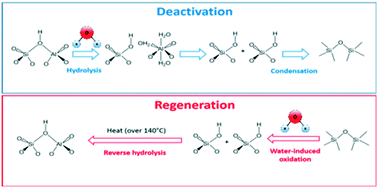Regeneration of Cu/SAPO-34(MO) with H2O only: too good to be true?†
Abstract
The performance failure of Cu/SAPO-34 material used as an NH3-SCR catalyst at low temperature in the presence of water has caused a gradual withdrawal of its usage from the market. There is an urgent need to clearly understand its deactivation mechanism and to find a way to regenerate the Cu/SAPO-34 catalyst material. Interestingly and surprisingly, we have discovered that, under certain conditions, 10% H2O can regenerate a previously deactivated Cu/SAPO-34(MO), as long as its zeolite structure is maintained. By using experimental observations of NH3-SCR reaction, solid state NMR, NO-DRIFTS, and in situ H2-TPR, a mechanism is proposed which can explain both the deactivation and regeneration of Cu/SAPO-34(MO). We propose that the transformation of Si(4OAl) and Si(3OAl) to (2Al)Si(2OH) and (3Al)Si(OH) and the Si condensation in the pores of the framework, which result from H2O exposure, are responsible for the deactivation of Cu/SAPO-34(MO). We suggest that the formation of condensed Si which results in Si clusters, hinders the mobility of the linear complex, [Cu–(NH3)2]+, which is the active species during the low temperature NH3-SCR reaction. Moreover, we propose a regeneration mechanism when Cu/SAPO-34(MO) is exposed to 10% H2O, where the Si clusters are transformed back to Si–O–H bonds, and thereafter transferred back to the framework. This can explain the regeneration of deactivated Cu/SAPO-34(MO).



 Please wait while we load your content...
Please wait while we load your content...